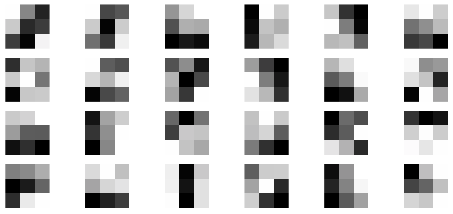Subspaces#
Subspaces of \(\mathbb{R}^n\) include lines, planes and hyperplanes through the origin. A basis of a subspace is a linearly independent set of spanning vectors. The Rank-Nullity Theorem describes the dimensions of the nullspace and range of a matrix.

Subspaces#
A subset \(U \subseteq \mathbb{R}^n\) is a subspace if:
\(U\) contains the zero vector \(\boldsymbol{0}\)
\(\boldsymbol{u}_1 + \boldsymbol{u}_2 \in U\) for all \(\boldsymbol{u}_1,\boldsymbol{u}_2 \in U\)
\(c \boldsymbol{u} \in U\) for all \(c \in \mathbb{R},\boldsymbol{u} \in U\)
Condition 2 is called closed under addition. Condition 3 is called closed under scalar multiplication. Condition 3 with \(c=0\) implies Condition 1.
The zero subspace \(\{ \boldsymbol{0} \}\) and the entire space \(\mathbb{R}^n\) are both subspaces of \(\mathbb{R}^n\).
Subspaces of \(\mathbb{R}^2\) include any line through the origin.
Subspaces of \(\mathbb{R}^3\) include any line or plane through the origin.
In general, subspaces of \(\mathbb{R}^n\) are hyperplanes of any dimension through the origin.
Consider the set
Is \(U \subset \mathbb{R}^2\) a subspace?
Solution
Then \(U\) contains the zero vector
and \(U\) is closed under addition since
because \(y_1 + y_2 \geq 0\) since \(y_1 \geq 0\) and \(y_2 \geq 0\). However \(U\) is not closed under scalar multiplication because
Therefore \(U\) is not a subspace of \(\mathbb{R}^2\).
Linear Independence and Span#
A linear combination of vectors \(\boldsymbol{u}_1,\dots,\boldsymbol{u}_m \in \mathbb{R}^n\) is a vector
where \(c_1,\dots,c_m \in \mathbb{R}\). The span of vectors \(\boldsymbol{u}_1,\dots,\boldsymbol{u}_m \in \mathbb{R}^n\) is the set of all linear combinations
Let \(\boldsymbol{u}_1 , \dots , \boldsymbol{u}_m \in \mathbb{R}^n\). Then \(\mathrm{span} \{ \boldsymbol{u}_1 , \dots , \boldsymbol{u}_m \}\) is a subspace of \(\mathbb{R}^n\).
The span of a single nonzero vector \(\boldsymbol{u}\) is a line with direction \(\boldsymbol{u}\). The span of two nonzero vectors \(\boldsymbol{u}\) and \(\boldsymbol{v}\) is a plane as long as \(\boldsymbol{u}\) and \(\boldsymbol{v}\) are not colinear.
A set of vectors \(\{ \boldsymbol{u}_1,\dots,\boldsymbol{u}_m \} \subset \mathbb{R}^n\) forms a linearly independent set if the vectors satisfy the property:
In other words, \(\{ \boldsymbol{u}_1,\dots,\boldsymbol{u}_m \}\) is a linearly independent set if no vector in the set can be expressed as a linear combination of the others.
How do we know if a set of vectors \(\{ \boldsymbol{u}_1,\dots,\boldsymbol{u}_m \}\) is linearly independent? Create a matrix where the columns are the given vectors
Then \(\{ \boldsymbol{u}_1,\dots,\boldsymbol{u}_m \}\) is a linearly independent set if and only if the linear system \(A \boldsymbol{x} = \boldsymbol{0}\) has only the trivial solution \(\boldsymbol{x} = \boldsymbol{0}\).
Basis and Dimension#
Let \(U \subseteq \mathbb{R}^n\) be a subspace. A set of vectors \(\{ \boldsymbol{u}_1 , \dots , \boldsymbol{u}_m \}\) forms a basis of \(U\) if:
\(\{ \boldsymbol{u}_1 , \dots , \boldsymbol{u}_m \}\) is a linearly independent set
\(\mathrm{span} \{ \boldsymbol{u}_1 , \dots , \boldsymbol{u}_m \} = U\)
The dimension of \(U\) is the number \(m\) of vectors in a basis.
Note that the first condition in the preceding definition guarantees that basis are minimal i.e. contain the smallest number of vectors which span the vectorspace \(U\).
Exercises#
Determine whether or not the set
is a subspace of \(\mathbb{R}^3\).
Solution
\(U\) is not a subspace because it is not closed under vector addition.
Determine whether \(\mathrm{span} \{ \boldsymbol{u}_1 , \boldsymbol{u}_2 \} = \mathrm{span} \{ \boldsymbol{u}_3 , \boldsymbol{u}_4 \}\) where
Solution
\(\mathrm{span} \{ \boldsymbol{u}_1 , \boldsymbol{u}_2 \} \ne \mathrm{span} \{ \boldsymbol{u}_3 , \boldsymbol{u}_4 \}\) since \(\boldsymbol{u}_1,\boldsymbol{u}_2,\boldsymbol{u}_4\) are linearly independent.
Let \(U = \mathrm{span} \{ \boldsymbol{u}_1 , \boldsymbol{u}_2 , \boldsymbol{u}_3 , \boldsymbol{u}_4 \} \subseteq \mathbb{R}^4\) where
Find a basis and the dimension of \(U\).
Is \(\{ \boldsymbol{u}_1 , \boldsymbol{u}_3 , \boldsymbol{u}_4 \}\) a basis of \(U\)? Explain.
Solution
\(\dim(U) = 3\) and \(\{ \boldsymbol{u}_1 , \boldsymbol{u}_3 , \boldsymbol{u}_4 \}\) also forms a basis of \(U\).
